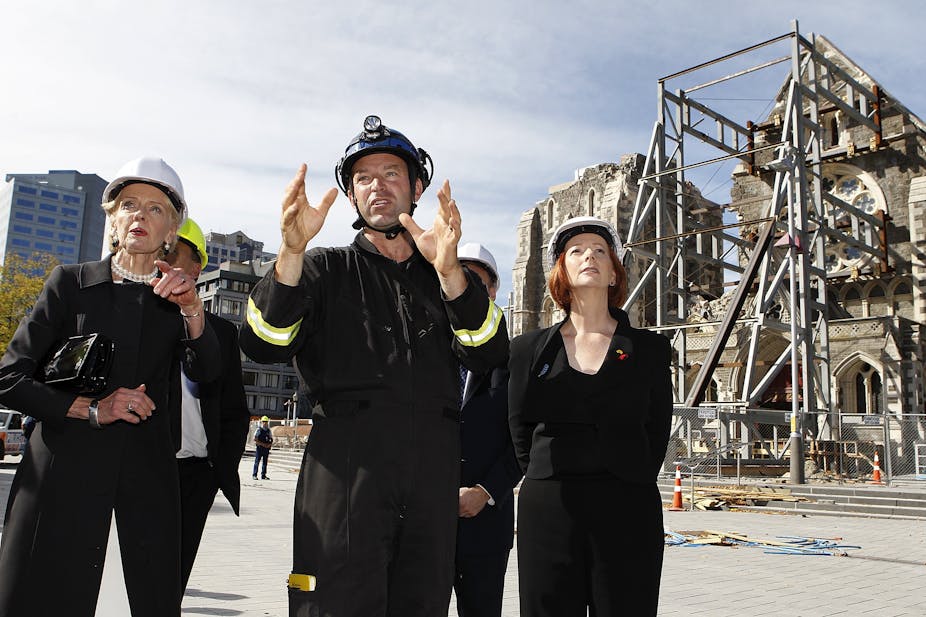February’s events in Christchurch brought people’s attention to the patently obvious: that old brick buildings collapse in large earthquakes.
There is no shortage of past lessons regarding this fact – only a general complacency to acknowledge the hazard. The reasons for this are obvious: earthquakes are infrequent and unpredictable natural hazards, such that people generally assume that they themselves will never be involved in one.
Furthermore, once they have been involved in a large earthquake, people are likely to assume a repeat will never occur, just as lightening never strikes twice.
To do something about the vulnerability of old brick buildings so that they better withstand earthquakes costs money, and there is always something more urgent that the money could be spent on.
So we ignore the lesson from the Napier earthquake in 1931, which killed 256 people, and the lesson from the Newcastle earthquake in 1989, which killed 13 and injured more than 160.
On both sides of the ditch, we happily go to brunch on Sunday in the funky cafe at the corner of the street with the interesting brick patterns on the wall. We give no thought to how the building might perform in an earthquake or what the old part of town would look like if the walls fell out of every building on Main Street.
In reality, earthquakes don’t kill people – collapsed buildings kill people. And the majority of these deaths occur in buildings constructed of either bricks or adobe.
It’s worth noting last year’s Haiti earthquake and the first Christchurch earthquake, last September, had almost identical characteristics in terms of both size and the vicinity of the earthquakes to a large city.
These events resulted in an approximated death toll of 316,000 people in Haiti (recently upgraded from the earlier count of 250,000) and zero deaths in Christchurch.
The stark contrast reveals two important facts:
1) Construction practices downunder, both now and when our old brick buildings were new, are superior to those of developing countries, which is a conclusion that most people would take for granted.
2) A large dose of good luck was associated with the timing of the first Christchurch earthquake – 4.30am on a Saturday morning – with the central business district practically deserted.
Clearly, Christchurch was not so lucky in the February 22 earthquake, which struck at the end of the lunch hour on a Tuesday afternoon.
Excluding two collapsed concrete buildings, the majority of injuries and fatalities were associated with the falling debris as several hundred old brick buildings, which either partially or completely collapsed in the space of about 10 seconds.
Past events cannot be undone, of course, but we are beholden to ask ourselves what we have learned from events in Christchurch, so that we can act before the memory again fades.
In New Zealand, the construction of unreinforced brick buildings has been legislated against for nearly 50 years, but in fact has been unfashionable ever since the Napier quake.
But in Australia, which admittedly has a far smaller earthquake risk, this form of construction is still common. This means there is a large number of buildings throughout Australia that could be expected to collapse in a major earthquake.
New Zealand legislation has defined an “Earthquake Prone Building” as one that has less than a third of the strength of an equivalent building that would be constructed today using current design standards.
The goal of this legislation is to address these earthquake-prone buildings and remove the hazard that they represent, either by strengthening the building or by demolishing it.
Of course, most of these earthquake-prone buildings are the old brick buildings that help to remind us of our history and of who we are as a nation. To mindlessly demolish these reminders of our cultural identity would be viewed as a catastrophic attack on our architectural heritage. But something must be done.
Arguably there are now no earthquake-prone buildings left in Christchurch – they have all collapsed – but the authorities in Wellington have publicly released a list of earthquake-prone buildings so that individuals can make an informed decision about the risk of entering a building, and authorities in Auckland are soon to release a similar list.
So what does all of this mean for Australia? The reality is that there will, at some point, be a significantly-sized earthquake with an epicentre not too far from a major Australian city. And when that earthquake happens, the old brick buildings will collapse and people will be killed.
The old buildings of the city will be destroyed and the architectural landscape will be changed for ever.
Perhaps this risk pales against the annual hazards of bushfires and floods? Perhaps the threat of earthquakes can be ignored?
Or perhaps the earthquake will strike tomorrow. If so, be shocked but not surprised when the old brick buildings in your city collapse.

